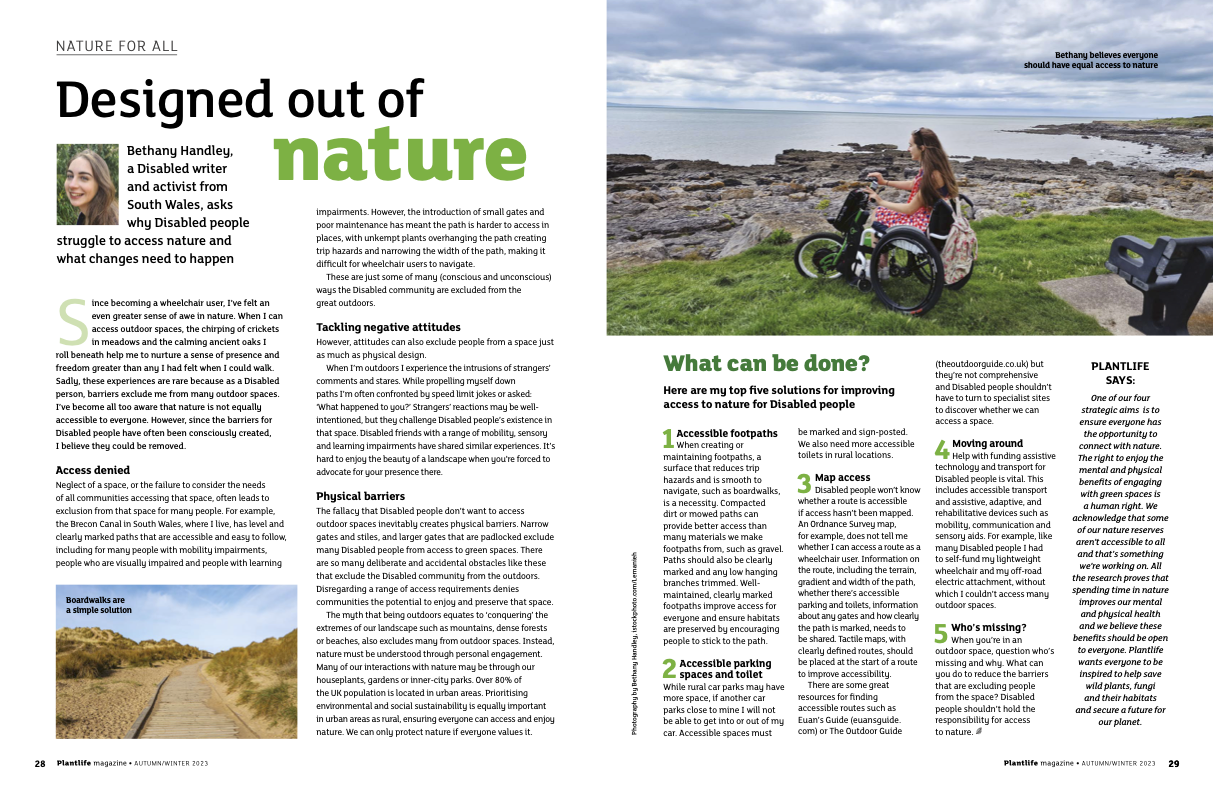Designed Out of Nature
In a feature for Plantlife Magazine, Bethany asks what barriers exist for Disabled people accessing nature and proposes five solutions for improving access.
Since becoming a wheelchair user, I’ve felt an even greater sense of awe in nature. When I can access outdoor spaces, the chirping of crickets in meadows and the calming ancient oaks I roll beneath help me to nurture a sense of presence and freedom greater than any I had felt when I could walk. Sadly, these experiences are rare because, as a Disabled person, barriers exclude me from many outdoor spaces. I’ve become all too aware that nature is not equally accessible to everyone. However, since the barriers for Disabled people have often been consciously created, I believe they can be removed.
Access denied
Neglect of a space, or the failure to consider the needs of all communities accessing that space, often leads to exclusion from that space for many people. For example, the Brecon Canal in South Wales, where I live, has level and clearly marked paths that are accessible and easy to follow, including for many people with mobility impairments, people who are visually impaired and people with learning impairments. However, the introduction of small gates and poor maintenance has meant the path is harder to access in places, with unkempt plants overhanging the path creating trip hazards and narrowing the width of the path, making it
difficult for wheelchair users to navigate.
These are just some of many (conscious and unconscious) ways the Disabled community are excluded from the great outdoors.
Tackling negative attitudes
However, attitudes can also exclude people from a space just as much as physical design.
When I’m outdoors I experience the intrusions of strangers’ comments and stares. While propelling myself down paths I’m often confronted by speed limit jokes or asked: ‘What happened to you?’ Strangers’ reactions may be well- intentioned, but they challenge Disabled people’s existence in that space. Disabled friends with a range of mobility, sensory and learning impairments have shared similar experiences. It’s hard to enjoy the beauty of a landscape when you’re forced to advocate for your presence there.
Physical barriers
The fallacy that Disabled people don’t want to access outdoor spaces inevitably creates physical barriers. Narrow gates and stiles, and larger gates that are padlocked exclude many Disabled people from access to green spaces. There are so many deliberate and accidental obstacles like these that exclude the Disabled community from the outdoors. Disregarding a range of access requirements denies communities the potential to enjoy and preserve that space.
The myth that being outdoors equates to ‘conquering’ the extremes of our landscape such as mountains, dense forests or beaches, also excludes many from outdoor spaces. Instead, nature must be understood through personal engagement. Many of our interactions with nature may be through our houseplants, gardens or inner-city parks. Over 80% of the UK population is located in urban areas. Prioritising environmental and social sustainability is equally important in urban areas as rural, ensuring everyone can access and enjoy nature. We can only protect nature if everyone values it.
What can be done?
Here are my top five solutions for improving access to nature for Disabled people
Accessible footpaths
When creating or maintaining footpaths, a surface that reduces trip hazards and is smooth to navigate, such as boardwalks, is a necessity. Compacted dirt or mowed paths can provide better access than many materials we make footpaths from, such as gravel. Paths should also be clearly marked and any low hanging branches should be trimmed. Well maintained clearly marked footpaths improve access for everyone and ensure habitats are preserved by encouraging people to stick to the path.
Accessible parking spaces and toilets
While rural car parks may have more space, if another car parks close to mine, I will not be able to get into or out of my car. Accessible spaces must be marked and sign posted. We also need more accessible toilets in rural locations.
Map access
Disabled people won’t know whether a route is accessible if access hasn’t been mapped. An Ordnance Survey map, for example, does not tell me whether I can access a route as a wheelchair user. Information on the route, including the terrain, gradient and width of the path, whether there’s accessible parking and toilets, whether there are narrow gates and how clearly the path is marked, needs to be shared. Tactile maps with clearly defined routes positioned at the start of a route can also improve accessibility.
There are some great resources for finding accessible routes such as Euan’s Guide or The Outdoor Guide but they’re not comprehensive and Disabled people shouldn’t have to turn to specialist sights to discover whether we can access a space.
Moving around
Help with funding assistive technology and transport for Disabled people is vital. This includes accessible transport and assistive, adaptive, and rehabilitative devices such as mobility, communication and sensory aids. For example, like many Disabled people, I had to self-fund my lightweight wheelchair and my off-road electric attachment, without which I would not be able to access outdoor spaces.
Who’s missing?
When you’re in an outdoor space, question who’s missing and why. What can you do to reduce the barriers that are excluding people from the space? Disabled people shouldn’t hold responsibility for access.
Plantlife says:
One of our four strategic aims is to ensure everyone has the opportunity to connect with nature. The right to enjoy the mental and physical benefits of engaging with green spaces is a human right. We acknowledge that some of our nature reserves aren’t accessible to all and that’s something we’re working on. All the research proves that spending time in nature improves our mental and physical health and we believe these benefits should be open to everyone. Plantlife wants everyone to be inspired to help save wild plants, fungi and their habitats and secure a future for our planet.

